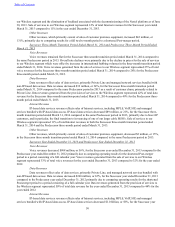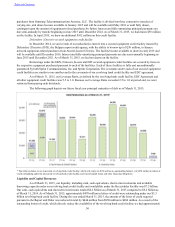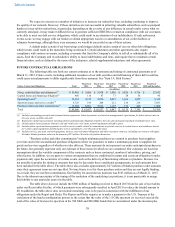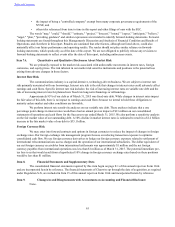Sprint - Nextel 2014 Annual Report Download - page 61
Download and view the complete annual report
Please find page 61 of the 2014 Sprint - Nextel annual report below. You can navigate through the pages in the report by either clicking on the pages listed below, or by using the keyword search tool below to find specific information within the annual report.
Table of Contents
59
the actual costs, or qualifying costs, that we incur to retune incumbents and our own facilities. From the inception of the
program through March 31, 2015, we have incurred approximately $3.4 billion of costs directly attributable to the spectrum
reconfiguration program. This amount does not include any of our internal network costs that we have preliminarily allocated
to the reconfiguration program for capacity sites and modifications for which we may request credit under the reconfiguration
program. We estimate, based on our experience to date with the reconfiguration program and on information currently
available, that our total direct costs attributable to complete the spectrum reconfigurations will range between $3.6 and $3.7
billion. Accordingly, we believe that it is unlikely that we will be required to make a payment to the U.S. Treasury.
OFF-BALANCE SHEET FINANCING
On May 16, 2014, certain wholly-owned subsidiaries of Sprint entered into the Receivables Facility, a two-year
committed facility, to sell certain accounts receivable (Receivables) on a revolving basis, subject to a maximum funding limit
of $1.3 billion. Sales of eligible Receivables, once initiated, generally occur daily and are settled on a monthly basis. Sprint
pays a fee for the drawn and undrawn portions of the Receivables Facility. The Receivables primarily consisted of installment
receivables and wireless service charges due from subscribers. On March 31, 2015, of the $3.5 billion of Receivables
contributed approximately $1.8 billion were sold in exchange for $500 million in cash and a $1.3 billion receivable. The
receivable due to Sprint is classified as a trading security and is recorded at its estimated fair value of $1.2 billion in "Prepaid
expenses and other current assets" on the consolidated balance sheet. As of March 31, 2015, there was approximately $460
million of available funding under the Receivables Facility. In April 2015, Sprint elected to remit payments received to
reduce the funded amount to zero. In addition, on April 24, 2015, the Receivables Facility was amended to include up to $2.0
billion of additional funding as a result of including installment receivables in the definition of eligible receivables under the
Receivable Facility, which had the effect of increasing the maximum funding limit to $3.3 billion and extending the
expiration date to March 31, 2017. As of April 30, 2015, the available funding under the amended Receivables Facility was
$1.4 billion.
Sprint's other off-balance sheet arrangements consist of the guarantee liabilities that arise from the option provided
to our subscribers to purchase, on a monthly basis, access to unlimited data coupled with an annual trade-in right, as
discussed under Guarantee Liabilities in the Critical Accounting Policies and Estimates below.
CRITICAL ACCOUNTING POLICIES AND ESTIMATES
Sprint applies those accounting policies that management believes best reflect the underlying business and
economic events, consistent with U.S. GAAP. Sprint's more critical accounting policies include allowance for doubtful
accounts, estimated economic lives and residual values of property, plant and equipment, valuation and recoverability of
long-lived assets, evaluation of goodwill and indefinite-lived assets for impairment and valuation of guarantee liabilities.
Inherent in such policies are certain key assumptions and estimates made by management. Management regularly updates its
estimates used in the preparation of the financial statements based on its latest assessment of the current and projected
business and general economic environment. Sprint's significant accounting policies and estimates are summarized in the
Notes to the Consolidated Financial Statements.
Allowance for Doubtful Accounts
We maintain an allowance for doubtful accounts for estimated losses that result from failure of our subscribers to
make required payments. Our estimate of the allowance for doubtful accounts considers a number of factors for each type of
receivable, including installment receivables, such as collection experience, installment billing arrangements, aging of the
accounts receivable portfolios, credit quality of the subscriber base, and other qualitative considerations. To the extent that
actual loss experience differs significantly from historical trends, the required allowance amounts could differ from our
estimate. A 10% change in the amount estimated to be uncollectible would result in a corresponding change in bad debt
expense of approximately $20 million for the Wireless segment and no material change for the Wireline segment.
Depreciation
Our property, plant and equipment balance represents a significant component of our consolidated assets. We
record property, plant and equipment at cost and depreciate it generally on a straight-line basis over the estimated useful life
of the assets. We expect that a one-year increase in estimated useful lives of our property, plant and equipment, exclusive of
leased devices, would have resulted in a decrease to our fiscal year 2014 depreciation expense of $700 million and that a one-
year decrease would have resulted in an increase of approximately $1.1 billion in our fiscal year 2014 depreciation expense.
























